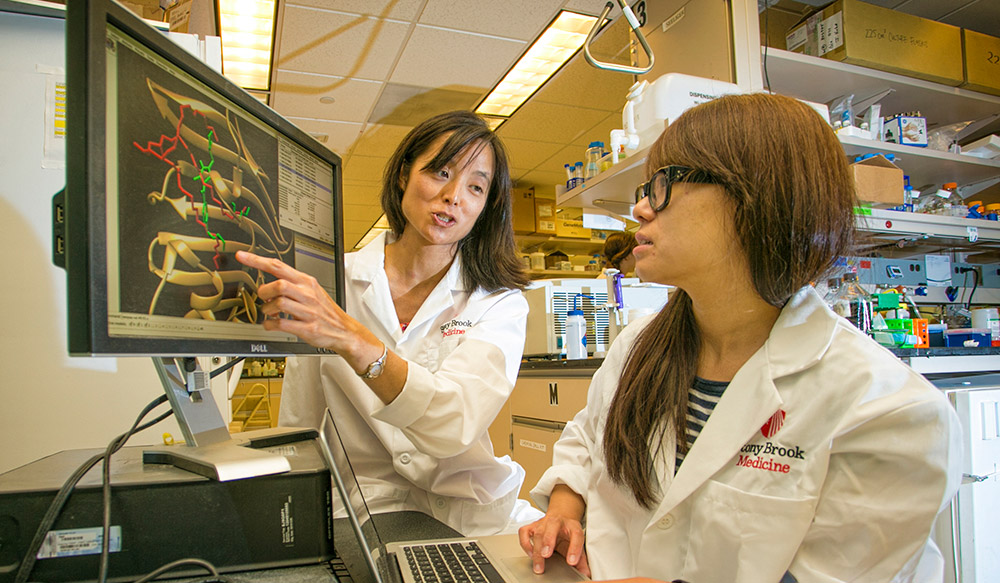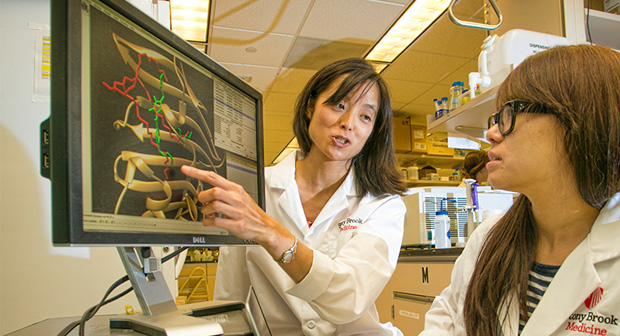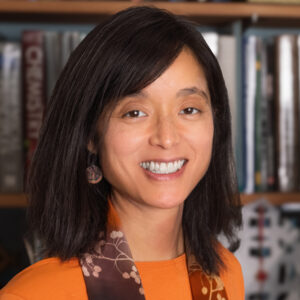
From studies in her lab at Stony Brook University in New York to private-sector collaborations, Hertz Fellow Jessica Seeliger is accelerating the fight against multiple deadly diseases.
Seeliger is an expert on mycobacteria—the “ducks of the microbial world,” so called for the thick, waxy outer coating that allows them to thrive in different environments and repel invaders.
Since her postdoc, she has focused on slowing or stopping tuberculosis (TB) caused by mycobacteria. She also is investigating mycobacteria that may be useful as an immunotherapy in cancer and as a vaccine platform for viruses like SARS-CoV-2, the virus that causes COVID-19.
“I enjoy running my lab so much because I have the opportunity to work on so many different projects involving mycobacteria,” Seeliger said.
One of those projects is a collaboration with Dr. Boris Shor, founder and CEO of Manhattan BioSolutions, who proposed using mycobacteria to fight bladder cancer.
“Scientific partnerships are largely about people,” Seeliger said. “I was fortunate that Boris is an excellent man in addition to being an excellent scientist. I agreed to test the waters, though I didn’t at first see this as a long-term partnership.”
Four years later, the partnership is going strong.
The fight against cancer
Shor enlisted Seeliger to supercharge a weakened strain of Mycobacterium bovis — known as bacillus Calmette-Guérin (BCG) — for testing in a mouse model of bladder cancer. BCG is approved for the treatment of bladder cancer, the sixth most common form of cancer. BCG has a good safety profile (in addition to its use as a cancer treatment, it is administered as a vaccine to infants at high risk for tuberculosis). Shor hypothesized that an engineered BCG would be even more effective as an immunotherapy for bladder cancer.
To leverage the mouse’s own immune defenses against the cancer cells, Seeliger and Shor first identified tumor-associated proteins, which are very different from normal cell proteins. Shor and Seeliger engineered tumor neoantigen sequences and inserted the sequences into the BCG. (A neoantigen is a protein that forms on cancer cells and triggers the body’s immune response.) The mouse immune system, they hoped, would recognize the neoantigens as non-self and kick into high gear.
To test this idea, they injected bladder cancer cells under the animals’ skin. The researchers monitored and measured the resulting tumors, which they treated with BCG and Seeliger’s engineered BCG. The results were encouraging.
The engineered BCG provoked an immune response to both the bacteria and to the cancer-associated protein that the bacteria was making. “The tumors resolved more quickly with our engineered strain of BCG than the original BCG. It’s very promising for future studies in other cancer models,” said Seeliger, noting that this was a preliminary study. In a February 23 press release, Shor said that the engineered BCG has the “potential to impact muscle-invasive, advanced and/or metastatic bladder cancer, a lethal disease with poor survival outcomes.”
Seeliger and Shor are taking a similar approach to developing BCG as a vaccine platform for SARS-CoV-2 and for other types of viruses. “Instead of inserting cancer antigens, we have inserted viral proteins. It’s analogous to the mRNA vaccines for COVID that are out there right now, but just on a different platform,” Seeliger said.
They also will try a different mode of stimulating the immune system in a colon cancer model. “We’re engineering BCG to express a protein that is naturally part of the immune system, not a tumor-specific protein,” she said. “We’re trying to get the bacteria to load more of the protein into the animal to stimulate a stronger immune response.”
Seeliger credits the Hertz Foundation for encouraging her to step outside of her safety zone while earning a PhD in chemistry from Stanford University.
“Throughout my fellowship, I was always in contact with a kind of fearlessness to just dive in. There’s always been community support for the idea that even though you were focusing in depth on one thing, you could continue to be engaged and curious about everything.”
Lipid membranes and tuberculosis
In her own lab, Seeliger is focused on identifying compounds that kill or prevent mycobacteria tuberculosis from growing. The need for such a compound is immense. In 2018, tuberculosis infected 1.7 billion people (roughly 23% of the world’s population). In fact, TB is the leading infectious disease killer in the world, claiming 1.5 million lives each year — and drug-resistant TB strains are on the rise.
“I’ve been working on tuberculosis since I began my postdoc in 2007,” Seeliger said. “People thought that TB was a solved problem, but it surged with the AIDS epidemic. People who are HIV positive have suppressed immune systems, which make it difficult for them to fight off TB. TB is actually the leading killer of HIV-positive individuals.”
In Seeliger’s search for ways to fight TB, she has focused in part on the mycobacteria’s lipid membrane. “I trained as a chemist and thought the structure of mycobacteria lipids was just so wild,” she said.
The lipid membrane has been described as a brick wall protecting the stuff inside the mycobacteria. Seeliger discovered that this brick wall is not only structural, but that the “bricks” are hurled out of the bacteria. “The lipid membrane becomes part of the way that the bacteria interacts with the host — that is, with us. These lipids don’t look like anything in our bodies, so the host sees them as something to attack.”
Seeliger has explored the function and inhibition of lipid transport mechanisms, or pathways, in the TB mycobacteria, hypothesizing that inhibiting these pathways could sensitize it to drugs and host mechanisms. She is also investigating the very basic biology of how mycobacteria make proteins.
“The protein carries out the functions in the cell,” she said. “We’re trying to understand more about how manipulating the DNA sequence actually leads to unexpected effects on the RNA and the resulting protein.”
The value of playing with others
It was almost inevitable that Seeliger would become interested in science. Her parents and sister are physicians, and her brother is a mathematician. “I was obviously always exposed to biology, biological processes and the practice of applying knowledge of the human body.” But she was also intensely curious about phenomena outside of biology. For a time, clouds fascinated her.
“We were learning about the weather, and I was totally obsessed by different forms of clouds,” Seeliger recalls. “I spent a lot of time in the car going to and from violin lessons, and I’d look out the car window at the clouds. I totally loved just looking up at the sky and saying, ‘Okay, that cloud is up high, and that means it’s icy. And that’s why it has that shape.’”
Seeliger continues to play the violin and viola, which she says provides both a counterbalance and metaphor for her work in the lab.
“I’m not a soloist. I’m no good at that,” Seeliger said. “When I was 9 or 10, I joined an orchestra and began to realize I could make something beautiful playing with others. The same thing is true about science. I have always loved research for the community aspect of it. So now I get to be partly a composer, but mostly a conductor of my own orchestra.”
Seeliger also loves being part of the Hertz Foundation “orchestra.”
“Hertz Fellows aren’t just politely interested in what you do, they are deeply curious and engaged and really want to understand,” she said. “That level of engagement makes me fearless about saying, what is it that you’re really doing? How can I help you, and how can I understand what you’re doing? I’m always looking for that level of engagement in my science, thanks to the community that I was able to be a part of.”
People thought that TB was a solved problem, but it surged with the AIDS epidemic.

